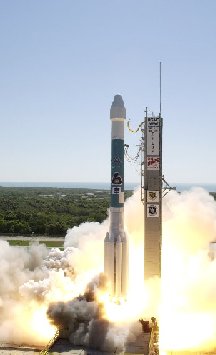Click on image for full size
Courtesy of NASA/JPL
Related links:
Mars Exploration Takes on a Whole New Look This Spring
News story originally written on April 19, 2001
In the 1990's, NASA was hit with the back-to-back loss of the spacecraft composing the Mars Observer and Mars '98 missions. About a year ago, things started to look up for Mars exploration. For the last year, the Mars Program Director, G. Scott Hubbard fixed problems and gave the NASA Mars Exploration program solid footing.
"Scott Hubbard was given 'mission impossible' and turned it
into 'mission accomplished,'" said Dr. Ed Weiler, Associate
Administrator for Space Science at NASA Headquarters. "When we
were hit with the back-to-back loss of two Mars missions, I
knew we had to get the best person on the job. Scott did a
top-to-bottom reorganization of the program, and earlier this month we had the first launch in the new program, the 2001 Mars Odyssey."Hubbard announced today that he will be leaving his post as Mars Program Director, but he will be leaving things in good hands. Orlando Figueroa will take Hubbards place. Dr. Weiler said, "I feel confident that the Mars program will be in extremely good hands. With Hubbard at the helm the past year and Figueroa ready to take charge, Mars exploration now has a solid basis to build on and a clear direction for the future."
Indeed, this new phase of Mars exploration has gotten off to a good start. The 2001 Mars Odyssey probe was launched on April 7, 2001. It is scheduled to arrive at Mars in October 2001. While it orbits the Red Planet, the Odyssey will remotely collect data about what chemicals and minerals make up the Martian surface. It will also provide vital information about potential radiation hazards for future human explorers.
Five other major Mars missions are being planned for the next decade. NASA plans to launch twin rovers which will land on Mars in 2003 and a powerful scientific orbiter to be launched in 2005. A mobile science laboratory and the first of several smaller Scout missions are planned for 2007. Wrapping up this phase of exploration would be a sample return mission possibly as early as 2011.















